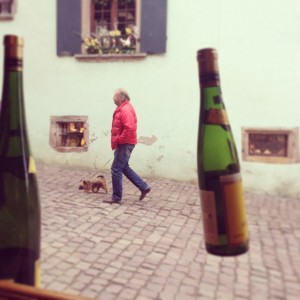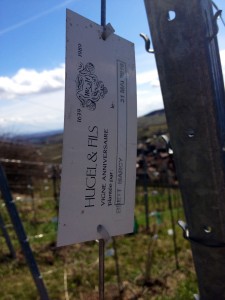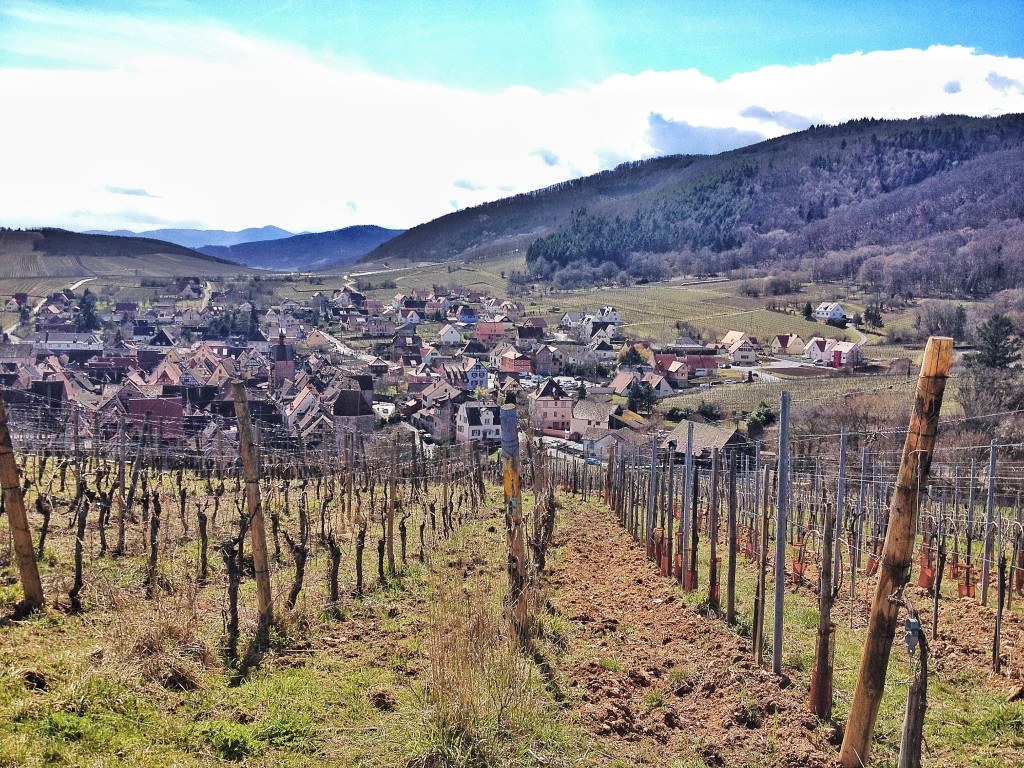Last week, I was fortunate enough to have the opportunity to visit two wineries in France. The first, Pol Roger, I wrote about in an earlier post. The second, Hugel et Fils, located in Alsace (a region of France that has, as a result of its close proximity to Germany, had to change its loyalties, language and friends every 50 years or so) produces beautifully complex and appealing wines that will change your mind about Rieslings and Gewürztraminers. I promise.
The Hugel family have been in Riquewihr since the 1600s – they’re almost locals at this point. They have  been growing wine in the region since 1639 and on April 10th, my boyfriend and I were met by the 13th generation of the Hugel family, Jean-Frédéric. Although only 24 years old, Jean-Frédéric has a command of viniculture, history and geography that is the result of coming from one of the oldest wine growing families in the region.
been growing wine in the region since 1639 and on April 10th, my boyfriend and I were met by the 13th generation of the Hugel family, Jean-Frédéric. Although only 24 years old, Jean-Frédéric has a command of viniculture, history and geography that is the result of coming from one of the oldest wine growing families in the region.
We started our visit by driving to the Schoenenbourg, the vine-filled hill that overlooks the picturesque village of Riquewihr. From this vantage point we could see the entire village as well as the long stretch of countryside that showed in-coming cloud storms caught between bursts of sunlight. From here, we moved to the almost-too-narrow-for-cars streets of Riquewihr, where half-timber houses craned their necks up to the sky and shop windows were still decorated for Easter. The twisting streets seemed a maze to the uninitiated, but Jean-Frédéric navigated them with the ease of someone whose family had been living here for, well, nearly 400 years.
The streets of Riquewihr moved us to the Hugel headquarters where we descended to the caves that house Hugel’s catalogue of wines, both in barrels and bottles, all unlabeled until the last moment. Working our way into the daylight, we entered the Hugel tasting room. Open to the public 7 days a week, it is a small, brightly lit space that looks out onto Riquewihr’s cobblestone streets. It was here that Jean-Frédéric led us through an intensive (and fun) vertical tasting of his family’s wine.
A note: Hugel wines have several classifications of wine (for example, their Riesling is available in the Tradition, Jubilee and Hommage a Jean Hugel categories to name a few). Please go to their excellent website for more detailed information – they do a much better job than I ever could of explaining these differences.
- Muscat Tradition 2010: I know that saying “dry” as a descriptor for a muscat doesn’t make sense, but I’m telling you, this is a
 light, dry, refreshing white wine that is made for sipping outside on a warm summer day – on its own or paired with white asparagus. barVino patrons will find this on our summer wine list (that is, if the snow ever goes away).
light, dry, refreshing white wine that is made for sipping outside on a warm summer day – on its own or paired with white asparagus. barVino patrons will find this on our summer wine list (that is, if the snow ever goes away). - Pinot Noir Jubilee 2007: With a complex nose and a great balance of acidity, this light wine has a bit of a bite on the end that reminds you that, yes, this is an Alsacan red.
- Riesling Jubilee 2007: The Hugels say it is the best Riesling they’ve made and has both the backbone and structure to age up to 20 years. It has minerality and acidity that make your mouth water and would be beyond perfect with any kind of food that has spice to it.
- A late harvest Pinot Gris 1998 (not available in the States, sadly): It is almost like a sherry with raisins and honey on the nose. This is a bottle that you share with friends after dinner, perhaps before a fire, and have them guess what they’re drinking. Because unless you know it’s a Pinot Gris, you’d never guess it’s a Pinot Gris.
- Gewürztraminer Selection de Grains Nobles 1988 (produced in very limited quantities): Bronze in color, it has an earthy nose and gorgeous legs that go on forever. Like the late harvest Pinot Gris, it has sherry-like qualities with dark honey notes. It coats your mouth with a spicy sweetness that goes on and on.
I must confess that my notes were better at the beginning of the tasting. The lack of detail towards the end came not from intoxication (I was actually quite professional and used the spit bucket provided), but because of how much I was enjoying the company, the stories and yes, the wine. As with my visit to Pol Roger, the wines of Hugel are now woven into a story of a place and family and the time that I was able to spend there, with them.
 Sauced In New York Sometimes the food is in the sauce, sometimes we are
Sauced In New York Sometimes the food is in the sauce, sometimes we are






Riesling is my favorite wine so am going to look next time at Total Wine. I so want to visit this region of France. Riquewihr does look like Germany. Great report.